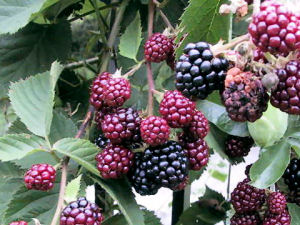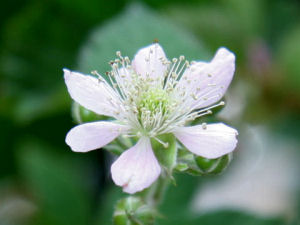
HOME
INTRO
SYMBOLS
ALMANAC
ECONOMY
GEOGRAPHY
STATE MAPS
PEOPLE
FORUM
NEWS
COOL SCHOOLS
STATE QUIZ
STATE LINKS
BOOK STORE
MARKETPLACE
GUESTBOOK
CONTACT US


Alabama State Fruit

Alabama State Fruit: Blackberry
Adoption of the Alabama State Fruit
The Alabama state fruit was adopted as part of a project by a pair of third grade teachers, Susan Sims and Amy Jones, and their students at Fairhope Elementary School.
The project took root in August of 2002. Students researched the fruit, wrote the legislation, and enlisted the help of State Senator Bradley Byrne of Fairhope and State Representative Randy Davis of Daphne to sponsor their proposal in the Alabama State Legislature.
Alabama State Senator Bradley Byrne first introduced Senate Bill No. 2 (SB2) on March 4, 2003.
A BILL
TO BE ENTITLED
AN ACTTo designate the Blackberry as the official state fruit for Alabama.
Section 1. The Blackberry, Rubus, R. occidentalis, is hereby designated and named as the official fruit of Alabama.
Section 2. This act shall become effective immediately following its passage and approval by the Governor, or its otherwise becoming law.
Senate Bill No. 2 was referred to the Senate Committee on Tourism and Marketing who voted in favor of the bill. It was read in the Senate a second time and placed on the calendar for the required third reading but went no further.
While Senator Bradley's bill was languishing in the Senate, Representative Davis introduced House Bill No. 643 (HB643), promoting the blackberry, in the State House of Representatives. Read for the first time on April 24, 2003, the bill was referred to the House Committee on Forestry and Agriculture. Unfortunately, Representative Davis' bill did not fair any better than the Senate version and it was "indefinitely postpone" on June 10, 2004.
Though the legislative session passed without an official state fruit and the third graders at Fairhope Elementary School passed into fourth grade, the idea and the proposal had not been forgotten.
In the next legislative session, Senator Bradley and Representative Davis took up the state fruit issue again. On February 2, 2004, Senator Bradley proposed honoring the blackberry as Alabama's official fruit with Senate Bill No. 163 (SB163) and, on February 26, 2004, Representative Davis presented a similar bill, House Bill No. 511 (HB511), in the House of Representatives.
This time, the proposal faired better than it had in 2003. SB163 was approved unanimously by the Senate on March 4, 2004.
Passed on to the House, SB163 ran into some resistance in the form of proposed amendments. Representative Todd Greeson, of Ider, offered an amendment substituting the "Sand Mountain Irish Potato as the official state vegetable for Alabama."
All attempts to derail the bill failed however and, on April 29, 2004, the Alabama House of Representatives voted 91-1 to approve the blackberry as the official fruit of Alabama.
On May 1, 2004, Governor Bill Riley signed the legislation at Fairhope Elementary school making the blackberry the official fruit of Alabama.
NOTE: Students at Fairhope Elementary School were also behind adoption of the Red Hills salamander as the official amphibian of Alabama in 2000.
Alabama Law
The following information was excerpted from the The Code of Alabama 1975, Title 1, Chapter 2, Section 1-2-35.
TITLE 1.
Chapter 2 STATE SYMBOLS AND HONORS.
Section 1-2-35 State fruit.
Section 1-2-35
State fruit.
The Blackberry, Rubus, R. occidentalis, is hereby designated and named as the official fruit of Alabama.
(Act 2004-363, p. 592, §1.)
Sources...
The Code of Alabama 1975. Alabama State Legislature. 2008. 8 October 2008
State Fruit of Alabama. Alabama Department of History & Archives. 2008. 8 October 2008
What's Juicy and Sweet and Fun to Eat?. Alabama Education News. Month 2004.
Third Grade Teacher: Susan Sims. Fairhope Elementary School. 2008. October 9, 2008

Blackberry Flower
Additional Information
State Fruit of Alabama: Alabama Department of Archives & History: Official Symbols and Emblems of Alabama.
Rubus occidentalis L. (Black raspberry): USDA, NRCS. 2004. The PLANTS Database, Version 3.5 (http://plants.usda.gov). National Plant Data Center, Baton Rouge, LA 70874-4490 USA.
Rubus occidentalis L. (Black raspberry): Virginia Tech, Department of Forestry: College of Natural Resources Fact Sheet.
Rubus occidentalis L. (Black raspberry): Bioimages from the Department of Biological Sciences of Vanderbilt University.
State Fruit: Complete list of official state fruit.
More symbols & emblems: Complete list of official Alabama state symbols.
The Alabama Fruit & Vegetable Book, by Walter Reeves and Felder Rushing, 312 pages, Cool Springs Press (April 5, 2002). Written by the highly popular gardening experts Walter Reeves and Felder Rushing, The Alabama Fruit & Vegetable Book contains advice for plant fruits, vegetables, and herbs. With 60 featured plants, the authors provide characteristics of available varieties, planting and maintenance advice, as well as recipes for dishes from the garden.

Fruits and Berries for the Home Garden
by Lewis Hill
Fruits and Berries for the Home Garden, by Lewis Hill. 280 pages. Storey Publishing, LLC; Revised edition (January 4, 1992) With over 45 years of growing fruits, nuts, and berries, Lewis Hill is an authority. Basic enough for novices and comprehensive enough for more experienced growers, the book features recommendations about new, improved fruit cultivars, effective and environmentally sound advice on how to fertilize plantings and control pests and diseases, complete information about what fruit to grow and where, and recommendations on improving the soil, planting, pruning, thinning, and other year-round maintenance suggestions for harvesting, preserving, and storage.
The Backyard Berry Book: A Hands-On Guide to Growing Berries, Brambles, and Vine Fruit in the Home Garden, by Stella Otto. 288 pages. Ottographics (April 1, 1995) Hands-on advice from a professional horticulturist and experienced fruit grower to help gardeners create an edible landscape. The Backyard Berry Book provides all the information that backyard gardeners need to grow strawberries, rhubarb, raspberries, blackberries, blueberries, lingonberries, currants, gooseberries, grapes, and kiwi fruit. Includes details on soil nutrition and testing; disease, pest, weed, and bird control; and trellis design.
Month-by-month Gardening In Alabama, by Bob Polomski. 368 pages. Cool Springs Press (April 11, 2002) Month-by-Month Gardening in Alabama is written by the highly regarded gardening expert Felder Rushing. Contains monthly advice on what to do and when to do it in the garden. The book contains 12 plant categories ranging from annuals to vines.
The Organic Gardener's Handbook of Natural Insect and Disease Control: A Complete Problem-Solving Guide to Keeping Your Garden and Yard Healthy Without Chemicals, edited by Barbara W. Ellis and Fern Marshall Bradley. 544 pages. Rodale Books; Revised edition (May 15, 1996) An excellent handbook with entries for common fruits, flowering plants, vegetables, and trees. Each listing has information on disease and pest problems and tips on how to solve them without chemicals. Especially useful sections feature photos of garden insects and diseases.
The Omnivore's Dilemma: A Natural History of Four Meals, by Michael Pollan. 464 pages. Penguin Press HC, The (April 11, 2006) The bestselling author of The Botany of Desire explores the ecology of eating to unveil why we consume what we consume in the twenty-first century
In Defense of Food: An Eater's Manifesto, by Michael Pollan. 256 pages. Penguin Press HC, The (2008) In looking toward traditional diets the world over, as well as the foods our families-and regions-historically enjoyed, we can recover a more balanced, reasonable, and pleasurable approach to food. Michael Pollan's bracing and eloquent manifesto shows us how we might start making thoughtful food choices that will enrich our lives and enlarge our sense of what it means to be healthy.
Garden tools from Amazon.com!
 Custom Search
Custom Search

